I'm looking for:
Bj index with details on +EV and frequency.
For example, theoretically (random fake numbers here, obviously just for illustrative purposes), doubling on 5 against dealer 4, TC 10, Frequency of TC 10+ is 10%, chance of encountering 5 v 4 is 5%, the EV averaged across and weighted all TC 10+ in a 5v4 decision is +0.05 Bet size.
Therefore 10%*5%*0.05= 0.025%. Using this hypothetical index decreases the housed edge by 0.025%. Basically useless.
I see many charts of illustrious 18. But I could never find a chart that has the data on how often each illustrious 18 data shows up. Let alone how profitable each of the indexes are.
This could be important in several ways though. For example, one way is, a new learner maybe doesn't need to learn and master all 18, but just the 4-5 that are the most frequent and most profitable (by +EV)
Or, If i'm considering cover plays, it's important for me to know which indexes I can skip. For %$*& sakes, I don't even double Soft 19 against 6 anymore. Seems to get a lot of heat for that move, especially from the dealer (not sure about pit boss), even though it's basic strategy, urgh. I made the decision of skipping doubling soft 19 vs 6 based on knowing the difference between double EV and stand EV is only -0.008 of bet size. Not worth the heat on a $100 bet just to save 80 cents, I think.
On that note, I also noticed dealers give a lot of heat for some other basic strategy moves like hitting 12 vs 2 etc.
Illustrious 18:
"I see many charts of illustrious 18. But I could never find a chart that has the data on how often each illustrious 18 data shows up. Let alone how profitable each of the indexes are."
In the link below, scroll down to the table - "Illustrious 18", it will tell you the order you should memorize them in (if you don't think you can remember or don't want to use them all).
https://wizardofodds.com/games/blackjack/card-counting/high-low/
----
EV and Frequency...:
"For example, theoretically (random fake numbers here, obviously just for illustrative purposes), doubling on 5 against dealer 4, TC 10, Frequency of TC 10+ is 10%, chance of encountering 5 v 4 is 5%, the EV averaged across and weighted all TC 10+ in a 5v4 decision is +0.05 Bet size..."
These Hand Calculators below may help with working out that stuff:
https://wizardofodds.com/games/blackjack/hand-calculator/
http://www.bjstrat.net/cgi-bin/cdca.cgi
Note: just try some combinations of each true count, and see what the average value is for each play you want to test (use a rough average "true count" value, since it would be very time consuming to go through every combination of cards).
----
Cover Plays:
" ... I don't even double Soft 19 against 6 anymore. Seems to get a lot of heat for that move ..."
Another good cover play is to always stand on hard 16 against a dealer 10 (more info about cover plays in the link below).
https://www.blackjackincolor.com/cardcountingcover1.htm
----
Other Info:
https://www.card-counting.com/cvcxonlineviewer3.htm (index info)
https://www.blackjackincolor.com/index.htm (general info)
EV and Frequency: Below is a site with links to what the "...expected returns for each initial hands..." are:
https://wizardofodds.com/games/blackjack/expected-values/
----
Cover Plays: Always taking insurance could be a good play as well. But I am not 100% sure on this one, so maybe wait until someone else confirms if this is correct or not (it could possibly have a different answer, depending on things like "how big/wide a bet spread you plan to use").
Update/Edit (about 2135, Pac Time):
https://www.blackjackincolor.com/cardcountingcover1.htm
https://www.blackjackincolor.com/cardcountingcover7.htm
The links above are just the first and last page about cover on that particular site (there should be 7 pages in total).
Quote: VladPutinI've looked all over google trying to find it, but struggling hard. So I'm here because I heard people here are pretty smart.
I'm looking for:
Bj index with details on +EV and frequency.
For example, theoretically (random fake numbers here, obviously just for illustrative purposes), doubling on 5 against dealer 4, TC 10, Frequency of TC 10+ is 10%, chance of encountering 5 v 4 is 5%, the EV averaged across and weighted all TC 10+ in a 5v4 decision is +0.05 Bet size.
Therefore 10%*5%*0.05= 0.025%. Using this hypothetical index decreases the housed edge by 0.025%. Basically useless.
I see many charts of illustrious 18. But I could never find a chart that has the data on how often each illustrious 18 data shows up. Let alone how profitable each of the indexes are.
This could be important in several ways though. For example, one way is, a new learner maybe doesn't need to learn and master all 18, but just the 4-5 that are the most frequent and most profitable (by +EV)
Or, If i'm considering cover plays, it's important for me to know which indexes I can skip. For %$*& sakes, I don't even double Soft 19 against 6 anymore. Seems to get a lot of heat for that move, especially from the dealer (not sure about pit boss), even though it's basic strategy, urgh. I made the decision of skipping doubling soft 19 vs 6 based on knowing the difference between double EV and stand EV is only -0.008 of bet size. Not worth the heat on a $100 bet just to save 80 cents, I think.
On that note, I also noticed dealers give a lot of heat for some other basic strategy moves like hitting 12 vs 2 etc.
link to original post
I have changed your post to substitute symbols for the F-Bomb word. Warning: No hard profanity is allowed in this forum. Please read the forum rules here: Forum Rules
Welcome to the forum.
Quote: ksdjdjI decided to delete the updates and edits in my previous reply, and post them here instead:
EV and Frequency: Below is a site with links to what the "...expected returns for each initial hands..."
Thanks for all your links. This link here you posted is the closest to what I'm looking for. Although still a bit of distance off.
It seems like I can "sort of" get what I'm looking for if I add the probabilities of every single card combination in every single index and then use the calculator you linked to compare them during certain TC's.
However, that seems too "brute force ish" and would take forever. I'm sure someone probably done it in a more organized way, and posted it somewhere online, I just can't find it.
Moreover, the link only has probabilities of natural 2 card hands. But often indexes show up in context with more than 2 cards. For example, if I want to know how frequent 16 V T shows up, I can add up 10vT, 97vT, and 88vT from that link you sent. However, there's no way for me to account for something like 844vT. Hence I'm still lost at trying to figure out how often 16 v T shows up.
If you think hitting 12v2 or doubling 19v6 is bringing you heat, either it's your imagination, or you gotta work on your act. Most dealers don't know that it is the right play, and many will get annoyed at players for playing wrong, that is not equal to heat.
If they do think you're really good, you need to act dumber. These are not the plays you avoid for cover, these are correct plays that actually also provide cover!!!
I once lasted a while on a good double deck game (months) before the pit finally backed me off, then he told me he wasn't paying attention to my varying bets because I wasn't' playing basic strategy. I often stayed on 16v10 and 15v10 (he knew how to count but somehow never heard of index plays it seems)
Quote: VladPutinQuote: ksdjdjI decided to delete the updates and edits in my previous reply, and post them here instead:
EV and Frequency: Below is a site with links to what the "...expected returns for each initial hands..."
Thanks for all your links. This link here you posted is the closest to what I'm looking for. Although still a bit of distance off.
It seems like I can "sort of" get what I'm looking for if I add the probabilities of every single card combination in every single index and then use the calculator you linked to compare them during certain TC's.
However, that seems too "brute force ish" and would take forever. I'm sure someone probably done it in a more organized way, and posted it somewhere online, I just can't find it.
Moreover, the link only has probabilities of natural 2 card hands. But often indexes show up in context with more than 2 cards. For example, if I want to know how frequent 16 V T shows up, I can add up 10vT, 97vT, and 88vT from that link you sent. However, there's no way for me to account for something like 844vT. Hence I'm still lost at trying to figure out how often 16 v T shows up.
link to original post
It is also only for the initial cards (always a new shoe?) but it is fairly straight forward if very time consuming*** to work out the chances, at least for me (see example below).
***: Basically, what I think you meant when you said "brute force ish", right?
Using 844 v T as an example: that hand would have about a 1/3,949 chance of happening at the start of a new shoe, for a "6-deck, Dealer Peeks Game"
Note: It took me a while to get the above answer, even though the formula is "fairly straight forward" (other people on this site are better / faster at this sort of stuff than me).
----
Other Info / Extra Stuff:
The info below may be useful (I don't know how accurate the info is, since I personally don't know much about I18):
Quote: "... The 3 big plays in the I18 are roughly 60% of the advantage you get from using I18, and knowing when to take insurance is half of that 60%. ..." (see below, full quote should be in the post at the top of that link)
https://www.blackjackinfo.com/community/threads/how-much-is-the-illustrious-18-really-worth.3180/
The "Card Counting, Advanced Strategies" part of the site (see link below)
https://www.blackjackinfo.com/community/forums/skilled-play-card-counting-advanced-strategies.7/
This one is interesting, and I think it should help as well (see below)
https://www.blackjacktheforum.com/showthread.php?37014-Indices-and-their-importance-to-your-winning-variance/page2
Note: You can start at page 1 if you want, but the explanation at the bottom of page 2 is the best one I could see so far (but I have only looked at the first two pages).
And lastly, these related ones below
https://www.blackjackreview.com/wp/2016/07/28/what-are-the-top-play-variations-that-yield-the-greatest-gain-for-card-counters/
https://www.blackjackreview.com/wp/encyclopedia/i/#Illustrious18
Lastly, I hope the information you are looking for is in one of those links.
Quote: VladPutin
For example, theoretically (random fake numbers here, obviously just for illustrative purposes), doubling on 5 against dealer 4, TC 10, Frequency of TC 10+ is 10%, chance of encountering 5 v 4 is 5%, the EV averaged across and weighted all TC 10+ in a 5v4 decision is +0.05 Bet size.
Therefore 10%*5%*0.05= 0.025%. Using this hypothetical index decreases the housed edge by 0.025%. Basically useless.
Your numbers sound too high. What is your counting system to have a TC=10+ frequency of 10%? For the Hi-Lo system, it should be less than 1%. Right?
Also, while most blackjack authors say the top play variations for blackjack card counters are taking insurance and standing on 16vs10, I believe the top play variation is surrender. Can somebody verify?
Index plays, playing the same hand different are the second biggest "tell" of a card counter behind bet spread itself. Nothing we can do to eliminate the spread (although you can camouflage some), but we can eliminate or greatly reduce the varying play (index plays) at minimal cost. This concept is known as card counter basic strategy. I am not sure who gets credit for it.
It works like this. You want to make the play that is optimal at a true count of +3 (hi-lo), which is an advantage of 1% or higher. That is the point a card counter should have his bigger bets out (maybe not max bet, but bigger bets) and you want the play to be optimal for the larger bets. So you make the optimal play for every play at count of +3 and above (or you can choose +2 and above) and play it the same way all the time, eliminating this tell of playing the same hand differently. You will be playing the hand slightly wrong, or not optimal at negative counts, counts of zero and low positive counts of +1, maybe +2. But you have your smaller bets out at these points and that less optimal play amounts to very little.
Let's take a few examples. 12 vs 2. Basic strategy says to hit and stand at a count of +3 or more. So card counter basic strategy is to stand, which is the correct play @ +3 or more. At counts of +2 or less we are playing slightly wrong (not optimal) but at a very small cost with our small bet out.
Another is 16 vs 10. This one is actually a very big tell because it is the most common hand so it occurs frequently and dealer, pit, EITS can easily notice a player playing it differently. The index is actually zero. At zero and negative counts you should hit and all positive counts a player should stay. Obviously, this becomes a stay for all counts under card counter basic strategy. Even as the most frequent hand the cost of playing this not optimally at zero or negative counts is almost nothing. A fraction of a cent for $100 bets.
So you do that for all index plays. What ever the optimal play is for a count of +3, maybe even +2, becomes your basic strategy and you play all hands the same. You have eliminated the tell of varying play for the same hand. AND if you are a player that escapes at least some of the negative counts, with exit triggers and bathroom breaks, phone calls or just sitting out if allowed, the cost really becomes almost nothing.
The one play that becomes a bit of a problem using a card counter's basic strategy is the insurance bet. The cost of taking insurance below the threshold is a little more than the cost of these other plays. Again it is less of a cost if you escape at least some of the negative counts, but even at counts of zero, taking insurance is a bit of a cost. I mostly will eat that cost by taking the insurance as I want to eliminate the tell of playing differently COMPLETELY, but sometimes I play the "acting game". I will him and hall like I can't make up my mind and then say "I don't think he has it". . It is kind of corny, but it can work a time or two each session if you are not comfortable giving up that small cost.
Quote: kewljI want to make a case for not using index play. Might sound crazy at first but give it some thought.
Index plays, playing the same hand different are the second biggest "tell" of a card counter behind bet spread itself... (snip)
link to original post
Is the quote below correct (or close enough to correct) ?
"80% of your return from card counting comes from betting variation and 20% from playing deviations...."
Note 1: I am not a counter, but I vaguely remember reading that "80/20" thing from more than one source.
Note 2: Scroll half way down the page in the link here , to see the full quote
----
Update (~1345, Pac Time):
After further reading, the "80/20" thing, is likely to do with SCORE.
Someone else may be able to explain it better, since I only "sort of know" that it has something to do with "risk vs reward".
Quote: ksdjdjQuote: kewljI want to make a case for not using index play. Might sound crazy at first but give it some thought.
Index plays, playing the same hand different are the second biggest "tell" of a card counter behind bet spread itself... (snip)
link to original post
Is the quote below correct (or close enough to correct) ?
"80% of your return from card counting comes from betting variation and 20% from playing deviations...."
Note 1: I am not a counter, but I vaguely remember reading that "80/20" thing from more than one source.
Note 2: Scroll half way down the page in the link here , to see the full quote
link to original post
That 20% is the number that has been generally accepted for a while now. I'll leave it to the math guys to come up with the numbers, but would argue index plays account for even less in todays games, which for most are mediocre penetration 6 and 8 deck games. Back in the days of single deck games, dealt reasonably deep, index plays were much, much more valuable. A player playing a really good single deck game could turn the game +EV by JUST using index plays. But those games are long gone for most players and the few that remain are low limit and sweaty locations like Reno.
A player like Moses that plays or played Reno regularly may find more value in the index plays, but for most of us, playing today's games, the value is greatly diminished. That is why I believe there is more value in a card counter type basic strategy where you are getting a majority of whatever the smaller value is, especially at the hand with your larger bets, but completely eliminating one of the big tells of a card counter, which greatly increases longevity.
This made sense, but I decided if I was going to play one set of strategy plays, I wanted it to be the correct play for the majority of times that my larger bets were out. I wanted the times I was playing slightly wrong to be the times my smallest bets were out.
So I thought I had hit on something and was explaining my new strategy to another card counter that I network with and he said "oh you mean card counter's basic strategy". I looked it up and low and behold, it was ALREADY a thing! LOL. But that's ok, EVERYTHING I do, came from someone else. I just take all these good ideas and apply them with my own twists. I don't need to invent the wheel, I just want to use it. :)
- Insurance on single deck games (and maybe double deck games) This opportunity is now Gone With the Wind.
- 16 v T
I or a partner would maintain a side count for 16vT where 6 is counted as a high card. This is the most profitable situation to exploit in modern BJ games that don't offer Surrender but I strongly suggest not using a HiLo count where 6 is counted as a low card as a basis for making 16vT decisions. And to address kewlj's concerns about cover, I would put on an act about hating 16vT and wanting to guess at HIT/STAND. During a session, I might sometimes HIT on a 16vT when it is was marginally better to STAND, just as cover. That is more sensible than missing out on the 16vT vulnerability entirely.
-12 v 4 This razor thin strategy decision is adequately countable with the Hi-Lo counts. It just doesn't occur very often as compared to 16vT. In computer-perfect play you would keep track of the 9's and 8's, to maximize profit from changing your Hit/Stand decisions -but I never found that to be worth it.
Together with bet size variation, and wonging out on large negative counts, that was all I was able to handle.
******************************************
And I agree that it is unfortunate that no one posts such critical numbers as how often a 16vT situation occurs. I've calculated it for 8 decks but I'd have to search on my hard drive.
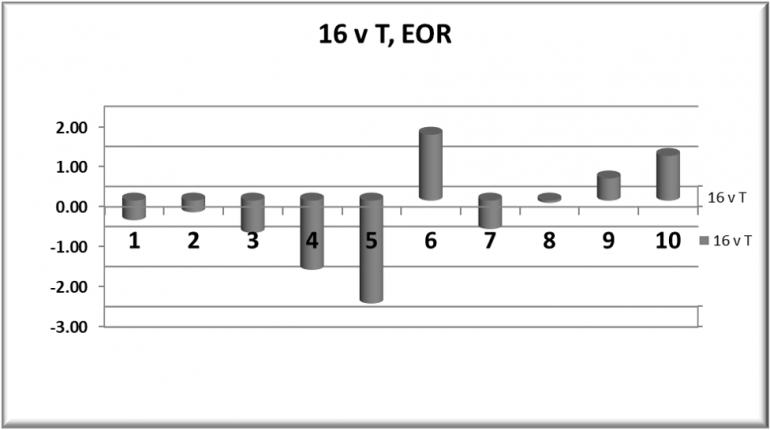
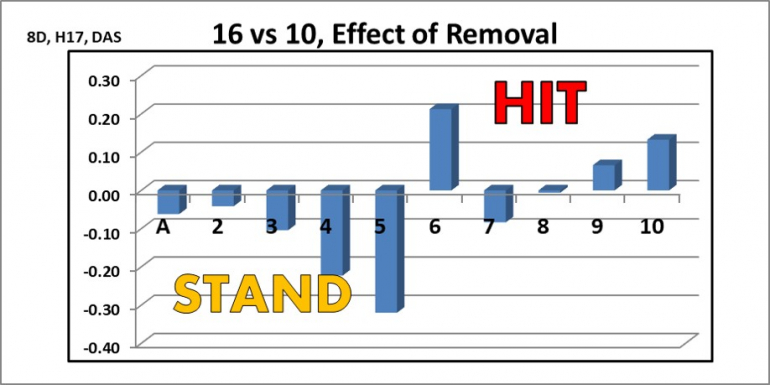
Quote: gordonm888Here are the EOR's for the 16vT decision. Any Counting system that counts a 6 as a low card and lumps it with 3-5 is reducing what you can get out of 16vT by almost a factor of 3.
g]]
This picture is amazing. Do you know where I can find pictures of the other equivalent pics for Il18?
So Ace is negative huh... interesting...
Quote: aceside
Your numbers sound too high. What is your counting system to have a TC=10+ frequency of 10%? For the Hi-Lo system, it should be less than 1%. Right?
Also, while most blackjack authors say the top play variations for blackjack card counters are taking insurance and standing on 16vs10, I believe the top play variation is surrender. Can somebody verify?
It was purely hypothetical with random numbers, to illustrate a point.
Quote: VladPutinQuote: gordonm888Here are the EOR's for the 16vT decision. Any Counting system that counts a 6 as a low card and lumps it with 3-5 is reducing what you can get out of 16vT by almost a factor of 3.
g]]
This picture is amazing. Do you know where I can find pictures of the other equivalent pics for Il18?
So Ace is negative huh... interesting...
link to original post
I have many of these diagrams on a file I just located. I'll try to post a few more. Some of them might not be on the I18 list because they are most sensitive to cards that are not captured by hi-low counts.
Do you have any specific ones that you are intrigued by?
Note: EORs are in %, whereas when I list the EV for certain decisions it is in absolute fraction, not %.
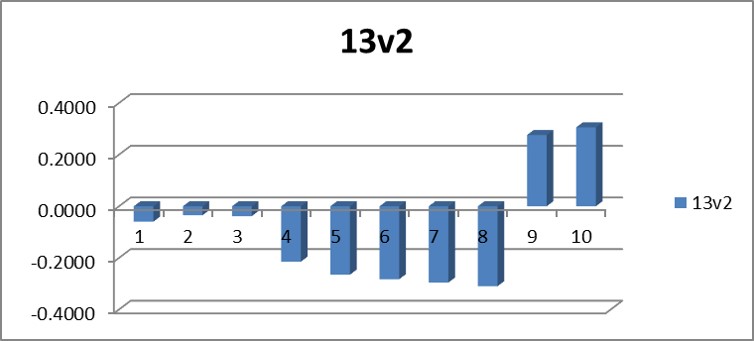
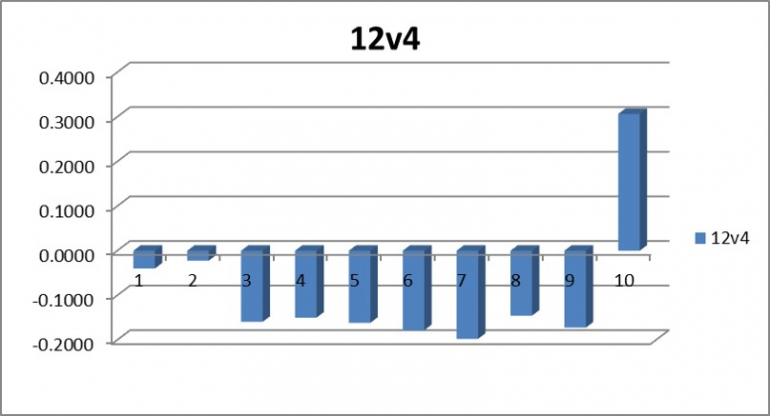
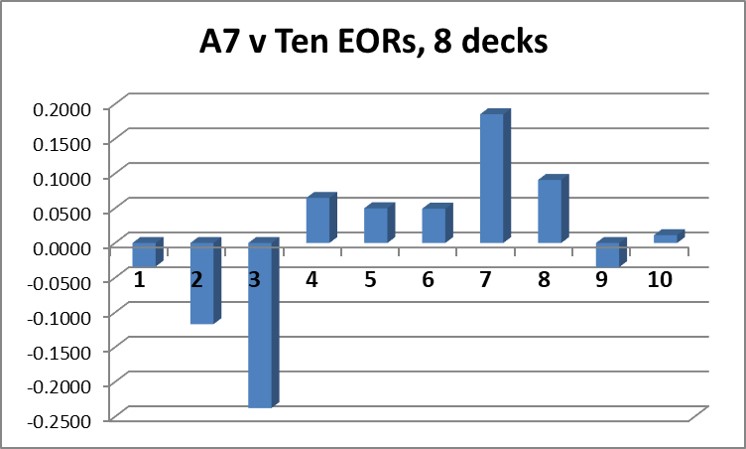
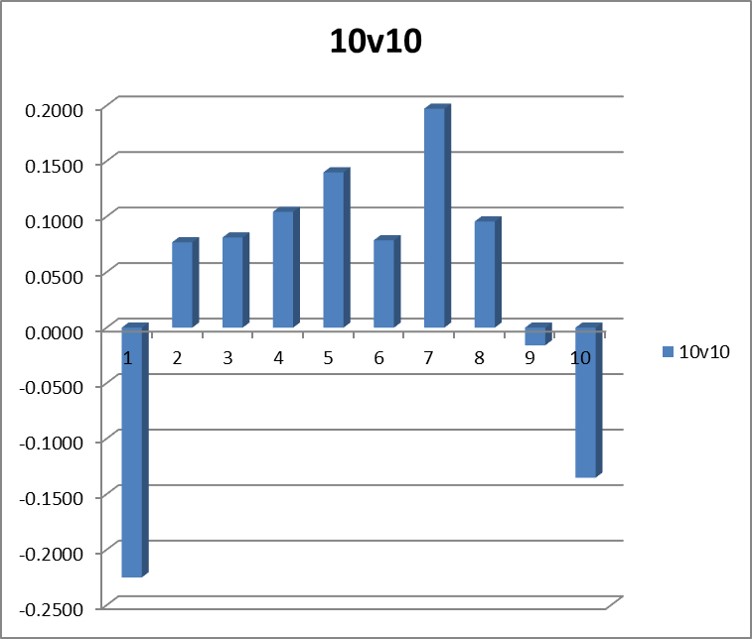
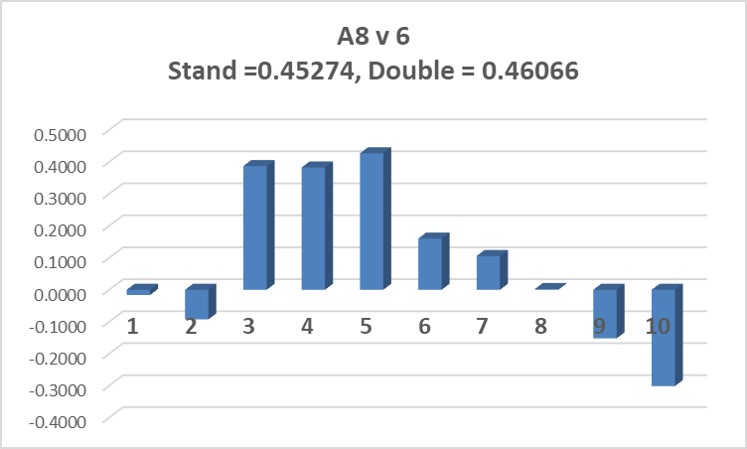
This one is seldom listed, because it is not captured by high-low counts.
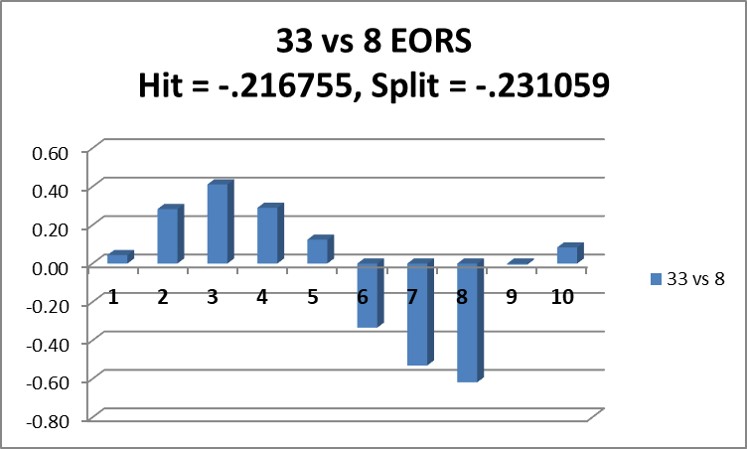
Quote: gordonm888
Do you have any specific ones that you are intrigued by?
Yes I do. The ones you posted so far are amazing and insightful. It seems like you hand made them yourself?
I'm kinda seeing a pattern of "if a card could make 11 or 21 in your current hand gets removed, that's bad"
I'm intrigued by SD basic strategy 77VT being stand. Wow, that's basically standing 14 against T, in basic strategy of all things too.
So I'm curious what the EOR for 14VT is in genera. And for comparison, I wonder what it would look like for 14V9 (and if it would ever even be a scenario where you'd stand 14V9)
Quote: gordonm888Here are the EOR's for the 16vT decision. Any Counting system that counts a 6 as a low card and lumps it with 3-5 is reducing what you can get out of 16vT by almost a factor of 3.
g]
g]]
So regarding 16vT. Am I understanding you correctly that:
1: 16VT is one of the most common indexes
2: 16VT is one of the most profitable indexes
3: Almost all counting systems gets 16VT wrong because of the 6
That's pretty shocking if it's common, profitable, and counting systems get it wrong.
But of course, I understand the concept of always standing 16VT for cover sakes, and I kinda do that most the time in 6-8 decks. Double deck ehh... much harder decision there.
Quote: VladPutinQuote: gordonm888Here are the EOR's for the 16vT decision. Any Counting system that counts a 6 as a low card and lumps it with 3-5 is reducing what you can get out of 16vT by almost a factor of 3.
g]
g]]
So regarding 16vT. Am I understanding you correctly that:
1: 16VT is one of the most common indexes
2: 16VT is one of the most profitable indexes
3: Almost all counting systems gets 16VT wrong because of the 6
That's pretty shocking if it's common, profitable, and counting systems get it wrong.
But of course, I understand the concept of always standing 16VT for cover sakes, and I kinda do that most the time in 6-8 decks. Double deck ehh... much harder decision there.
link to original post
Always good for cover to stand^^^ 16vT, and when the count is high it is even better.
Generally with double deck, you should be even happier to stand^^^ on 16vT (again, even more so when the count is high).
^^^ (Similar to what I said in the other thread that you started): Exception, if you were keeping track of each individual card-value, and there were "no 6's left in the shoe".
----
Update (0315, Pac Time);
Follow on to what gordonm888 already mentioned here, about "16 v T" , IMO only play like this if you (yourself, a partner, or a team) are keeping a side count of the 6's, otherwise the "16vT always stand" play is better***
***: Better overall in terms of "cover" and "maximizing EV".


